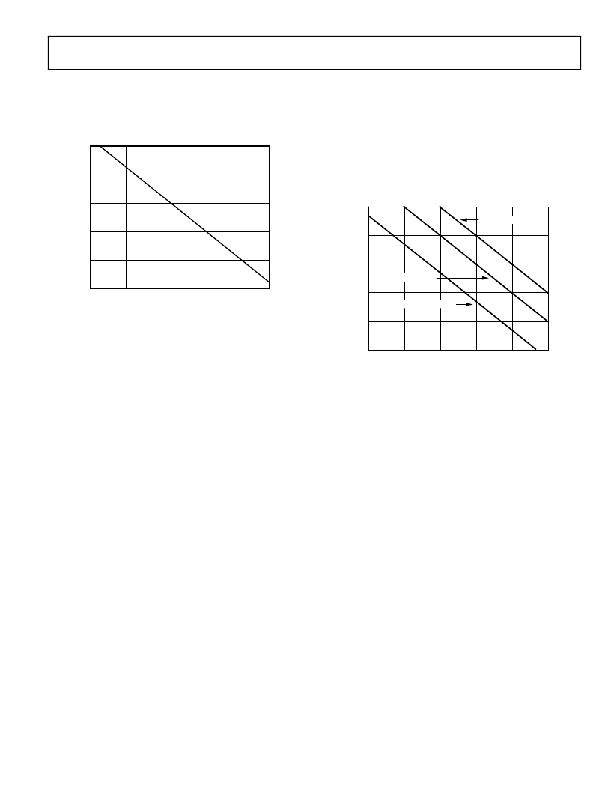- 您现在的位置:买卖IC网 > Sheet目录308 > ADUM3201WCRZ (Analog Devices Inc)ISOLATOR DGTL 25MBPS 2CH 8SOIC

Data Sheet
Given the geometry of the receiving coil in the ADuM3200 /
ADuM3201 and an imposed requirement that the induced
voltage is at most 50% of the 0.5 V margin at the decoder, a
maximum allowable magnetic field is calculated, as shown in
Figure 13.
100
10
1
0.1
0.01
ADuM3200/ADuM3201
The preceding magnetic flux density values correspond to
specific current magnitudes at given distances away from the
ADuM3200 / ADuM3201 transformers. Figure 14 expresses
these allowable current magnitudes as a function of frequency
for selected distances. As seen, the ADuM3200 / ADuM3201 are
extremely immune and can be affected only by extremely large
currents operated at high frequency and very close to the com-
ponent. For the 1 MHz example, one would have to place a 0.5 kA
current 5 mm away from the ADuM3200 / ADuM3201 to affect
the component’s operation.
1000
DISTANCE = 1m
100
10
DISTANCE = 100mm
0.001
1k
10k
100k
1M
10M
100M
1
MAGNETIC FIELD FREQUENCY (Hz)
Figure 13. Maximum Allowable External Magnetic Flux Density
For example, at a magnetic field frequency of 1 MHz, the
0.1
DISTANCE = 5mm
maximum allowable magnetic field of 0.2 kgauss induces a
voltage of 0.25 V at the receiving coil. This is about 50% of the
0.01
1k
10k
100k
1M
10M
100M
sensing threshold and does not cause a faulty output transition.
Similarly, if such an event were to occur during a transmitted
pulse (and had the worst-case polarity), it would reduce the
received pulse from >1.0 V to 0.75 V—still well above the
0.5 V sensing threshold of the decoder.
MAGNETIC FIELD FREQUENCY (Hz)
Figure 14. Maximum Allowable Current for Various
Current-to- ADuM3200 / ADuM3201 Spacings
Note that at combinations of strong magnetic fields and high
frequencies, any loops formed by printed circuit board traces
could induce sufficiently large error voltages to trigger the
threshold of succeeding circuitry. Care should be taken in
the layout of such traces to avoid this possibility.
Rev. C | Page 17 of 20
发布紧急采购,3分钟左右您将得到回复。
相关PDF资料
ADUM3210WCRZ
IC DIGITAL ISOLATOR 2CH 8-SOIC
ADUM3300CRWZ
IC DIGITAL ISOLATOR 3CH 16-SOIC
ADUM3400BRWZ
IC DIGITAL ISOLATOR 4CH 16-SOIC
ADUM3442CRWZ-RL
IC DIGITAL ISOLATOR 4CHAN 16SOIC
ADUM4223BRWZ
ISOLATOR DIGITAL
ADUM4402CRWZ
IC DIGITAL ISOLATOR 4CH 16-SOIC
ADUM5000ARWZ-RL
IC DIG ISOLATOR W/DC-DC 16SOIC
ADUM5201CRWZ
IC DGTL ISOLATOR W/DC-DC 16SOIC
相关代理商/技术参数
ADUM3201WCRZ-RL7
功能描述:ISOLATOR DGTL 25MBPS 2CH 8SOIC RoHS:是 类别:隔离器 >> 数字隔离器 系列:iCoupler® 产品培训模块:IsoLoop® Isolator 标准包装:50 系列:IsoLoop® 输入 - 1 侧/2 侧:5/0 通道数:5 电源电压:3 V ~ 5.5 V 电压 - 隔离:2500Vrms 数据速率:110Mbps 传输延迟:12ns 输出类型:CMOS 封装/外壳:16-SOIC(0.154",3.90mm 宽) 供应商设备封装:16-SOIC N 包装:管件 工作温度:-40°C ~ 85°C 其它名称:390-1053-5
ADUM320x
制造商:AD 制造商全称:Analog Devices 功能描述:Digital Isolator Product Selection and Resource Guide
ADUM3210
制造商:AD 制造商全称:Analog Devices 功能描述:Dual-Channel Digital Isolators, Enhanced System-Level ESD Reliability
ADUM3210_09
制造商:AD 制造商全称:Analog Devices 功能描述:Dual-Channel Digital Isolators, Enhanced System-Level ESD Reliability
ADUM3210_11
制造商:AD 制造商全称:Analog Devices 功能描述:Dual-Channel Digital Isolators, Enhanced System-Level ESD Reliability
ADUM3210ARZ
功能描述:IC ISOLATOR DGTL DUAL 8SOIC RoHS:是 类别:隔离器 >> 数字隔离器 系列:iCoupler® 标准包装:66 系列:iCoupler® 输入 - 1 侧/2 侧:2/2 通道数:4 电源电压:3.3V,5V 电压 - 隔离:2500Vrms 数据速率:25Mbps 传输延迟:60ns 输出类型:逻辑 封装/外壳:20-SSOP(0.209",5.30mm 宽) 供应商设备封装:20-SSOP 包装:管件 工作温度:-40°C ~ 105°C
ADUM3210ARZ-RL7
功能描述:IC DIGITAL ISOLATOR 2CH 8SOIC RoHS:是 类别:隔离器 >> 数字隔离器 系列:iCoupler® 产品培训模块:IsoLoop® Isolator 标准包装:50 系列:IsoLoop® 输入 - 1 侧/2 侧:5/0 通道数:5 电源电压:3 V ~ 5.5 V 电压 - 隔离:2500Vrms 数据速率:110Mbps 传输延迟:12ns 输出类型:CMOS 封装/外壳:16-SOIC(0.154",3.90mm 宽) 供应商设备封装:16-SOIC N 包装:管件 工作温度:-40°C ~ 85°C 其它名称:390-1053-5
ADUM3210BRZ
功能描述:IC DIGITAL ISOLATOR 2CH 8-SOIC RoHS:是 类别:隔离器 >> 数字隔离器 系列:iCoupler® 产品培训模块:IsoLoop® Isolator 标准包装:50 系列:IsoLoop® 输入 - 1 侧/2 侧:5/0 通道数:5 电源电压:3 V ~ 5.5 V 电压 - 隔离:2500Vrms 数据速率:110Mbps 传输延迟:12ns 输出类型:CMOS 封装/外壳:16-SOIC(0.154",3.90mm 宽) 供应商设备封装:16-SOIC N 包装:管件 工作温度:-40°C ~ 85°C 其它名称:390-1053-5
